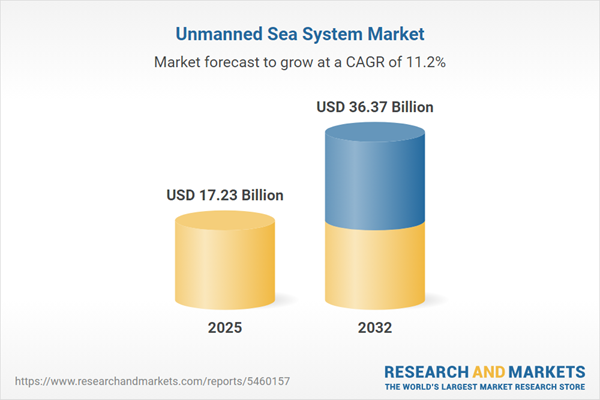Speak directly to the analyst to clarify any post sales queries you may have.
The unmanned sea system market is transforming how maritime organizations address operational risks, technological integration, and compliance in a rapidly evolving environment. Senior decision-makers now face a complex landscape that demands a strategic approach to autonomy, modularity, and collaboration for long-term resilience.
Market Snapshot: Growth and Trends in the Unmanned Sea System Market
The unmanned sea system market is advancing rapidly, with robust momentum observed across both commercial and defense applications. The sector is projected to achieve a compound annual growth rate (CAGR) of 11.16% through 2032, supported by increasing investments in remote maritime technology. Enhanced communication infrastructure and next-generation propulsion systems are propelling capabilities for unmanned surface vehicles (USVs) and unmanned underwater vehicles (UUVs), enabling longer missions and reliable, real-time data transfer. The shift toward modular architectures facilitates rapid deployment and reduced life-cycle costs, helping clients stay flexible as operational requirements shift. This evolution is prompting market participants to align offerings with sector needs for security, research, and infrastructure applications, ensuring solutions are tailored for end-user expectations.
Scope & Segmentation of the Unmanned Sea System Market
- Vehicle Types: Unmanned surface and underwater vehicles are deployed for surveillance, defense, marine exploration, and operational security in varied maritime settings.
- Autonomy Levels: Both fully autonomous and remotely piloted systems are available, enabling customized deployment aligned to mission needs.
- Hull Types: Rigid inflatable, single, twin, and triple hulls provide flexibility to overcome different environmental challenges and application-specific requirements.
- Communication Types: Connectivity options such as radio, satellite, UHF/VHF, and Wi-Fi support operational reliability in complex or remote maritime domains.
- Endurance Categories: Platforms are engineered for rapid short-term tasks as well as extended missions, offering adaptive operational flexibility.
- Platform Sizes: Variants range from compact reconnaissance vehicles to larger, multi-role platforms, addressing the needs of science, defense, and industry.
- Propulsion Systems: Diesel, gasoline, electric, hybrid, and renewable propulsion technologies contribute to efficient operations and compliance with sustainability guidelines.
- Applications: Core utilization areas include environmental monitoring, marine research, search and rescue, mine detection, naval activities, and critical infrastructure inspection.
- Geographic Regions: The market spans the Americas, Europe, Middle East and Africa, and Asia-Pacific, each shaped by distinctive operational priorities and regulatory landscapes, influencing technology uptake and deployment strategies.
- Company Coverage: Key industry players are BlueZone Group, Deep Ocean Engineering, Elbit Systems Ltd., Exail Technologies, Fugro N.V., General Dynamics Mission Systems, HD Hyundai Heavy Industries, Israel Aerospace Industries, Kongsberg Gruppen, L3Harris Technologies, and Lockheed Martin.
Key Takeaways for Senior Decision-Makers
- Adoption of modular and autonomous platforms enhances response speed and optimizes resource utilization as operational needs shift.
- Integration of artificial intelligence and advanced sensors increases overall maritime situational awareness, supporting risk reduction and automation.
- Greater collaboration among suppliers, operators, and users minimizes deployment risks and promotes readiness throughout the supply chain.
- Aligning procurement and investment strategies to technological advancements and compliance requirements ensures continued adaptability and regulatory confidence.
- Emphasizing process standardization and ongoing workforce upskilling maximizes the value of technology investments and cross-functional performance.
Tariff Impact: Strategic Response to 2025 US Measures
Upcoming 2025 United States tariffs on navigation and sonar components require industry stakeholders to re-examine supply chain strategies. Responses such as adopting nearshoring practices, diversifying supplier relationships, and enhancing risk management help mitigate potential disruptions. Organizations that quickly adapt will be best positioned to maintain operational continuity amid shifting trade policy dynamics.
Methodology & Data Sources
This analysis is grounded in structured interviews with senior industry executives and benchmarking studies from technology leaders. Comprehensive project reviews and expert validation ensure findings are practical, actionable, and directly guide leadership decisions.
Why This Report Matters
- Delivers actionable guidance for integrating advanced maritime technologies, building robust supply chains, and strengthening risk management frameworks in unmanned sea system operations.
- Clarifies compliance imperatives and operational priorities region by region, allowing organizations to optimize investments and adjust strategic positioning effectively.
- Supports agile workforce development and procurement strategies, preparing leadership teams for evolving regulatory and technological landscapes.
Conclusion
Technological flexibility, strategic partnerships, and workforce development are essential for sustaining competitive advantage in unmanned sea systems. This report equips senior leaders with insights to inform resilient growth and effective risk governance in a dynamic sector.
Additional Product Information:
- Purchase of this report includes 1 year online access with quarterly updates.
- This report can be updated on request. Please contact our Customer Experience team using the Ask a Question widget on our website.
Table of Contents
3. Executive Summary
4. Market Overview
7. Cumulative Impact of Artificial Intelligence 2025
List of Figures
Companies Mentioned
The companies profiled in this Unmanned Sea System market report include:- BlueZone Group
- Deep Ocean Engineering, Inc.
- Elbit Systems Ltd.
- Exail Technologies SA
- Fugro N.V.
- General Dynamics Mission Systems, Inc.
- HD Hyundai Heavy Industries Co., Ltd.
- Israel Aerospace Industries Ltd
- Kongsberg Gruppen ASA
- L3Harris Technologies, Inc.
- Lockheed Martin Corporation
- Maritime Robotics AS
- Ocean Power Technologies, Inc.
- OceanAlpha Group Ltd.
- Ocius Technology
- Saab AB
- Sagar Defence Engineering
- Saildrone Inc.
- Sea Machines Robotics, Inc.
- SeaRobotics Corp. by Advanced Ocean Systems
- Singapore Technologies Engineering Ltd
- SIREHNA by Naval Group
- Sonardyne International Ltd. by Covelya Group
- Teledyne Technologies Incorporated
- Textron Systems Corporation
- Thales Group
- The Boeing Company
- The QinetiQ Group
- Van Oord nv by MerweOord B.V.
- Xylem Inc.
Table Information
| Report Attribute | Details |
|---|---|
| No. of Pages | 183 |
| Published | November 2025 |
| Forecast Period | 2025 - 2032 |
| Estimated Market Value ( USD | $ 17.23 Billion |
| Forecasted Market Value ( USD | $ 36.37 Billion |
| Compound Annual Growth Rate | 11.1% |
| Regions Covered | Global |
| No. of Companies Mentioned | 31 |









